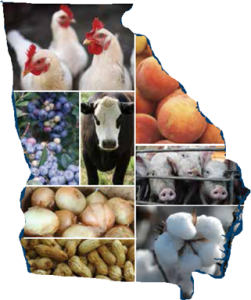
Heather N. Kolich, ANR Agent, UGA Extension Forsyth County
For many holidays and family celebrations, food is a central feature. What would an Independence Day picnic be without watermelon? Can you host a tail-gate or game-day party without chicken wings, hamburgers, or bar-b-que? In my family, dinner get-togethers aren’t complete without an apple, peach, blueberry, or pumpkin pie, depending on the season. And my most-requested cookies wouldn’t be so popular without Georgia Grown pecans.
It’s Georgia farmers, in fact, who lead the nation in producing pecans, peanuts, blueberries, and broiler chickens, and are the second largest producers of watermelons. They also touch our daily lives through other crops. Georgia cotton is the fiber that makes our comfy jeans, tees, and flannel shirts, as well as smooth-sleeping sheets and fluffy bath towels. Pines, another top commodity for Georgia farmers, supply lumber for the homes in which we host family and friends, as well as pulpwood for paper products, disposable diapers, and many other comforts and conveniences in our lives.
Although farmers represent less than two percent of the U.S. population, in Georgia, they fuel the largest segment of our state’s economy. The food, timber, and fiber farmers grow support numerous other industries at both the in-put and the out-out phases of the farm production cycle. Farmers purchase equipment, supplies, and seeds or transplants from various manufacturers in order to produce the crops that supply mills and processing plants with the raw materials that they convert into finished products. The finished products then go to retail stores that make goods available to us. All of these businesses rely on the transportation industry to move materials between each stage of production and distribution. As a whole, the Georgia agriculture system provides over 410,000 jobs and contributes over $73 billion dollars to the state’s economy each year.

Unfortunately, there’s a less predictable factor in the agricultural production system: weather. This year, in the aftermath of Hurricane Michael, Georgia farmers are hurting. As the storm swept through South Georgia with history-making force, it killed 2 million chickens, destroyed over 27,000 acres of pecan trees, devastated bumper cotton crops, caused severe to catastrophic damage to timber stands in a dozen counties, wiped out $480 million worth of vegetables, and damaged other agriculture businesses. Total losses are estimated at over $2.5 billion.
Since 97 percent of U.S. farms are family owned, these losses aren’t just business; they’re personal. The loss of a cotton crop represents months of work and the income farmers rely on to support their families. The loss of a timber stand represents years of lost labor. And while pecan trees can be replanted, it will be more than a decade before they’re mature enough to produce nuts.
In addition to crop and livestock losses, farmers also sustained damage to fences, farm buildings, irrigation systems, and their homes. Many are wondering how, or if, they can rebuild or recover financially. The average age of the principal farm owner in Georgia is nearly 60 years, an age at which many of us anticipate retirement.
After Hurricane Michael’s force dwindled and roads were cleared and reopened in affected counties, many Georgians donated water and other goods to the disaster relief effort for South Georgia. But the physical and emotional stress of trying to restore a farm that’s been worked by several generations – in addition to financial worries – takes a toll on farm families.
You can see some of the damage Hurricane Michael caused to Georgia farms at the Georgia Department of Agriculture’s Hurricane Response Center. You can also make a donation to help Georgia farmers recover and rebuild through the Georgia Farm Bureau. During certain hours on Giving Tuesday, GFB will match or double your donation.
As we celebrate the holidays with friends and family, let’s also remember the farmers who produce the bounty we enjoy, and who are themselves in need this season.